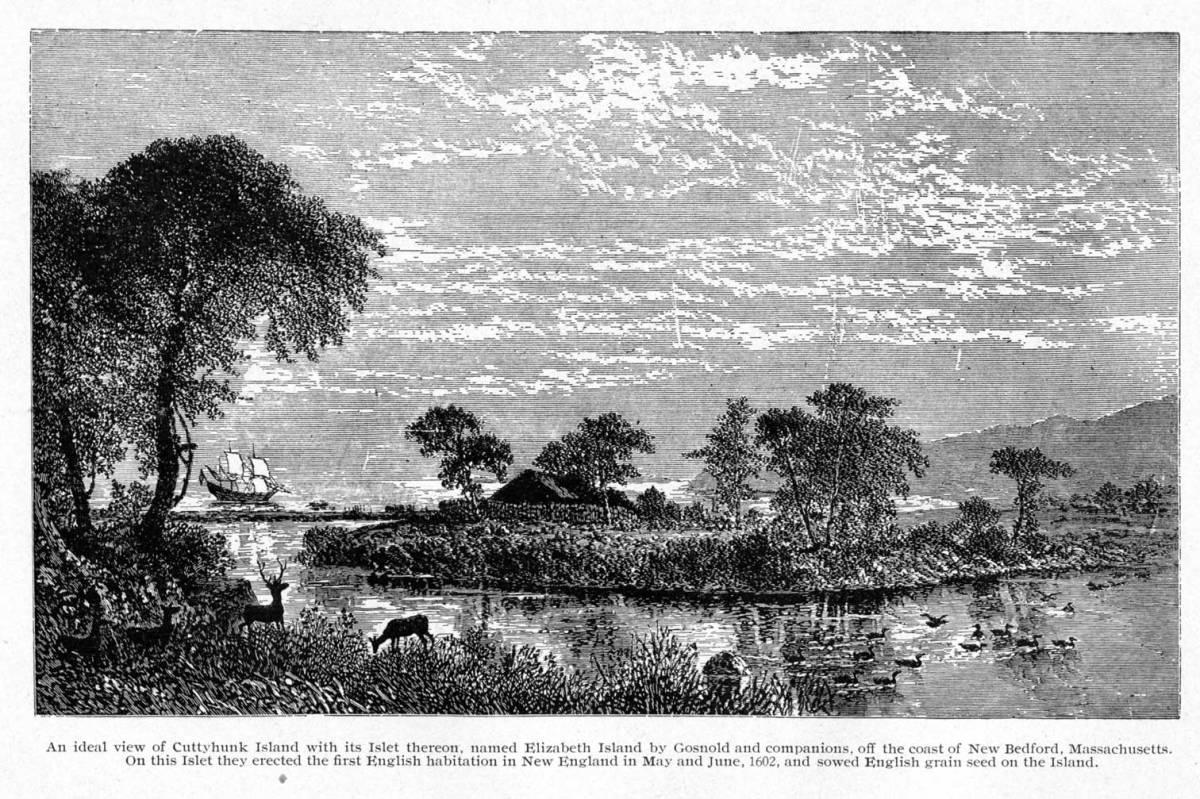A largely forgotten man named Bartholomew Gosnold made the first English attempt to colonize New England.
Gosnold was born in 1561 into an East Anglian manorial family. He got his first taste at sea in the Essex/Raleigh Expedition to the Azores in 1597, and upon his return, somehow got the colonization bug. It had been fifteen years since Walter Raleigh’s third attempt to settle at Roanoke had resulted in the famous “lost colony.” Gosnold ignored the fact that Sir Walter had the royal charter authorizing him to explore, colonize, and rule unoccupied North American territory.
Gosnold was initially backed by Robert Devereux, Earl of Essex, but his plan got stalled when the earl was beheaded in 1601 for conspiring against Queen Elizabeth. Gosnold regrouped and obtained the support of Henry Wriothesley, third earl of Southampton, although he too was imprisoned for a while as part of the Essex plot.
On March 26, 1602, Gosnold’s expedition departed Falmouth on the ship Concord, carrying twenty gentleman colonists and a dozen crewmembers. The Concord was a small, uncomfortable ship that had a keel length of only 39 feet, a breadth of 17½ feet, and leaked badly. Instead of making a circuitous route to North America by the Canary Islands as other explorers had done, Gosnold traveled due west and was the first to travel a direct route to New England. In only seven weeks, he made landfall at what is now Cape Elizabeth, near Portland, Maine. While exploring the area, he famously encountered a Mi’kmaq who was wearing black serge breeches and a European waistcoat.
In May 1602, Gosnold continued southward in search of an appropriate site for settlement. He navigated around a peninsula he named Cape Cod, after the large number of fish swimming in the surrounding waters. He went ashore there and was among the first Europeans to trade with the Nauset people. Continuing on, he discovered a large island he named Martha’s Vineyard in memory of his first child and the wild grapes that covered it.
At Martha’s Vineyard, Gosnold encountered the Wampanoag people, who proved to be friendly, bringing the Englishman cooked fish, deerskins, and tobacco. Gosnold kept on moving, and finally selected the small island of Cuttyhunk, west of Martha’s Vineyard, for his settlement. Here he built a small fort on an island in the middle of a large freshwater lake, which he reached with a flat-bottomed boat.
The colonists found fertile land and plenty of sassafras to harvest, which would bring them a high profit in England. In the early 1600s, sassafras was believed to be a wonder drug that could cure just about anything. It became so popular that by the mid-1600s, it was America’s number two export to Europe, second only to Virginia tobacco.
As the summer progressed, Gosnold and the locals traded actively and had mostly congenial interactions. A group of six or seven of them even worked side-by-side with Gosnold’s men, helping cut and carry the sassafras.
As the summer progressed, the colonists began to lose their enthusiasm for settlement, realizing that their supplies were likely too short to last the winter. They also had an unfortunate skirmish where two Englishmen hunting for shellfish were attacked by four locals who shot one in the side with an arrow. This incident scared the colonists, making clear how vulnerable their little settlement was to the whims of the Indigenous people.
The original plan was for the colonists to split into two groups when their ship was full of sassafras – one group was to sail back to England with their harvested bounty and the other was to stay through the winter. After a sharp dispute as to who would go and who would stay, Gosnold gave in to a majority vote, and after only a month on the island, everyone sailed back to England, carrying a profitable cargo of cedar wood, sassafras, furs, and a stolen Wampanoag canoe.
Soon after their return, Sir Walter Raleigh found out about Gosnold’s mission and laid claim to the cargo. However, the two quickly make peace. Gosnold had many powerful friends like the Earl of Southampton and Raleigh came to see the success of the mission as a good advertisement for future ventures that he might conduct.
The colony of Gosnold’s would be ephemeral, but its story would live long after. William Shakespeare based his play “The Tempest” on Gosnold’s 1602 voyage, with Prospero’s island being drawn from the descriptions of Martha’s Vineyard.
Gosnold would go on to be one of the key organizers of the successful Jamestown settlement. Now mostly forgotten, he deserves much greater recognition. Dana Huntley (2023) calls Gosnold: “a man who perhaps more than any other single individual is responsible for the establishment of British North America, a man whom history ought to have recognized in one sense as at least the Founding Grandfather of these fair colonies.”
Illustration:
Artist’s conception of the fort built by Bartholomew Gosnold’s expedition on Elizabeth Islet, Cuttyhunk in May/June 1602. Robert Maitland Brereton, Reminiscences of an Old English Civil Engineer 1858-1908.
Bibliography:
Quinn, D. B. and Quinn, A. M. (1983) Gabriel Archer’s account of Captain Bartholomew Gosnold’s voyage to ‘North Virginia’ in 1602. In: The English New England voyages, 1602-1608. Hakluyt Society, London. pgs 112-138.
Huntley, D. (2023) Bartholomew Gosnold – How England settled in the New World. British Heritage Travel. https://britishheritage.com/history/bartholomew-gosnold-englands-settled-new-world
Levermore, C. H. (1912) Forerunners and Competitors of the Pilgrims and Puritans. 2 vols. Brooklyn: New England Society.
